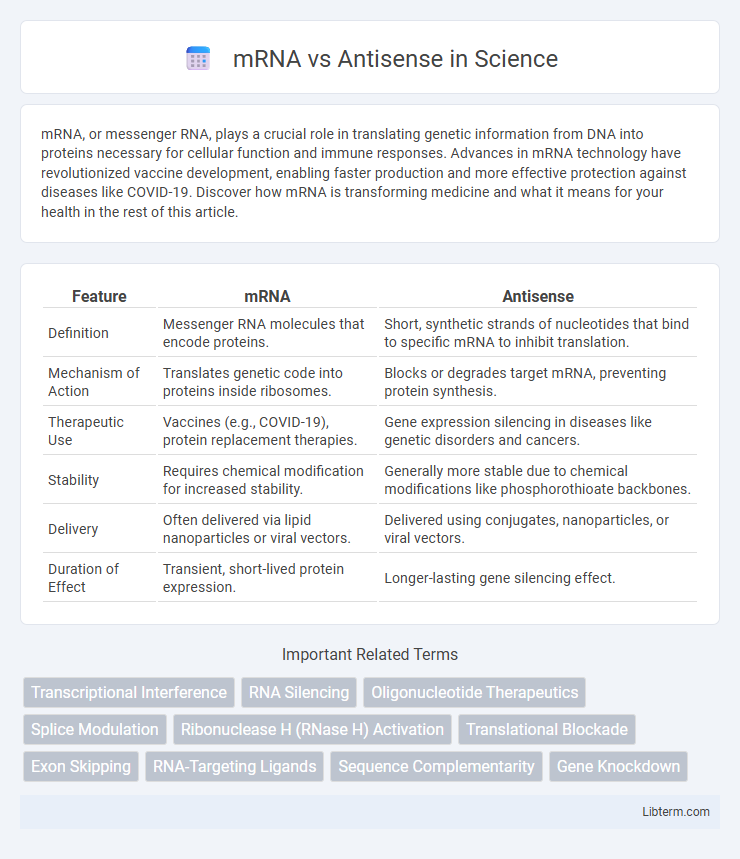mRNA, or messenger RNA, plays a crucial role in translating genetic information from DNA into proteins necessary for cellular function and immune responses. Advances in mRNA technology have revolutionized vaccine development, enabling faster production and more effective protection against diseases like COVID-19. Discover how mRNA is transforming medicine and what it means for your health in the rest of this article.
Table of Comparison
| Feature | mRNA | Antisense |
|---|---|---|
| Definition | Messenger RNA molecules that encode proteins. | Short, synthetic strands of nucleotides that bind to specific mRNA to inhibit translation. |
| Mechanism of Action | Translates genetic code into proteins inside ribosomes. | Blocks or degrades target mRNA, preventing protein synthesis. |
| Therapeutic Use | Vaccines (e.g., COVID-19), protein replacement therapies. | Gene expression silencing in diseases like genetic disorders and cancers. |
| Stability | Requires chemical modification for increased stability. | Generally more stable due to chemical modifications like phosphorothioate backbones. |
| Delivery | Often delivered via lipid nanoparticles or viral vectors. | Delivered using conjugates, nanoparticles, or viral vectors. |
| Duration of Effect | Transient, short-lived protein expression. | Longer-lasting gene silencing effect. |
Introduction to mRNA and Antisense Technologies
mRNA technology utilizes synthetic messenger RNA molecules to instruct cells in producing specific proteins, enabling rapid development of vaccines and therapeutics. Antisense technology involves small, synthetic strands of nucleic acids designed to bind complementary mRNA sequences, preventing translation and modulating gene expression. Both approaches leverage nucleic acid-based methods but differ fundamentally in mechanism: mRNA promotes protein synthesis, while antisense inhibits it.
Mechanisms of Action: mRNA vs Antisense
mRNA therapies function by delivering messenger RNA sequences into cells, which are then translated by ribosomes into specific proteins that can treat or prevent diseases. Antisense oligonucleotides (ASOs) bind complementary mRNA strands, blocking translation or inducing RNase H-mediated degradation to reduce the expression of targeted proteins. While mRNA therapies upregulate protein production by providing templates for synthesis, antisense therapeutics downregulate protein output by interfering with mRNA stability or translation processes.
Applications in Therapeutics
mRNA therapies deliver synthetic messenger RNA to cells, instructing them to produce specific proteins to treat diseases such as cancer and genetic disorders, with COVID-19 vaccines being a prominent example. Antisense oligonucleotides (ASOs) work by binding to target mRNA sequences, modulating gene expression to silence or modify protein production, used effectively in treating conditions like spinal muscular atrophy and Duchenne muscular dystrophy. Both platforms offer precision in therapeutic targeting but differ in mechanisms: mRNA introduces functional proteins, while antisense reduces harmful protein synthesis.
Advantages of mRNA-Based Approaches
mRNA-based approaches offer rapid development and scalable manufacturing, enabling swift responses to emerging infectious diseases and personalized medicine applications. Unlike antisense therapies that target existing RNA to inhibit gene expression, mRNA therapeutics introduce synthetic mRNA to produce desired proteins, providing direct protein replacement or immunization. The versatility of mRNA vaccines and therapeutics allows robust immune activation and precise control over protein expression, enhancing efficacy and safety profiles.
Advantages of Antisense Oligonucleotides
Antisense oligonucleotides (ASOs) offer precise gene silencing by binding directly to target mRNA, enabling modulation of gene expression without altering the genome. They demonstrate high specificity and versatility in targeting diverse RNA sequences, including splice variants and non-coding RNAs, providing therapeutic potential for genetic and acquired diseases. ASOs also exhibit improved stability and reduced immunogenicity compared to mRNA-based therapies, facilitating more controlled and sustained biological effects.
Safety and Delivery Challenges
mRNA therapies face challenges in safe delivery due to their instability and potential for immune activation, requiring encapsulation in lipid nanoparticles to enhance cellular uptake and reduce degradation. Antisense oligonucleotides (ASOs) exhibit improved stability but can trigger off-target effects and immune responses, necessitating chemical modifications to improve safety profiles. Both platforms demand careful optimization of delivery systems to minimize toxicity while maximizing efficacy in target tissues.
Regulatory Approvals and Clinical Trials
mRNA therapeutics have gained significant regulatory approval momentum, with multiple mRNA vaccines and treatments authorized by agencies such as the FDA and EMA, supported by robust clinical trial data demonstrating safety and efficacy. In contrast, antisense oligonucleotides (ASOs) have received regulatory approval primarily for rare genetic disorders, with ongoing clinical trials exploring broader applications in neurology, oncology, and infectious diseases. Both modalities continue to expand their clinical trial pipelines, leveraging advances in delivery technologies and bioinformatics to enhance target specificity and therapeutic outcomes.
Current Market Landscape
The current market landscape for mRNA therapeutics is rapidly expanding, driven by breakthroughs in vaccine development and personalized medicine, with leading companies like Moderna and BioNTech spearheading innovation. Antisense oligonucleotides hold a niche yet growing segment, targeting genetic disorders with FDA-approved treatments such as Spinraza for spinal muscular atrophy, showcasing their clinical potential. Investment trends and R&D pipelines indicate robust growth potential in both modalities, with mRNA's versatility outpacing antisense in market valuation and therapeutic applications.
Future Prospects and Innovations
mRNA technology is rapidly advancing with potential applications beyond vaccines, including personalized cancer therapies and protein replacement treatments, driven by improvements in delivery systems and nucleotide modifications. Antisense oligonucleotides (ASOs) continue to evolve with enhanced specificity and reduced off-target effects, enabling treatment of genetic disorders and neurodegenerative diseases previously considered untreatable. Future innovations in both platforms are likely to converge, integrating mRNA and antisense mechanisms for customizable, multi-targeted therapeutic strategies with improved efficacy and safety profiles.
Conclusion: Choosing Between mRNA and Antisense
Choosing between mRNA and antisense therapies depends on the specific disease target, mechanism of action, and desired therapeutic outcome. mRNA therapeutics excel in protein replacement and vaccine development by encoding proteins directly, while antisense oligonucleotides modulate gene expression by degrading or modifying RNA transcripts. Careful evaluation of delivery methods, target tissue, and duration of effect is critical to determine the optimal approach for clinical applications.
mRNA Infographic

 libterm.com
libterm.com